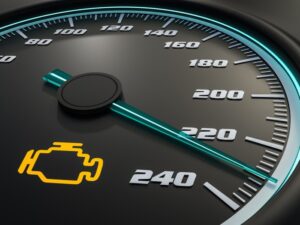
When the check engine light illuminates on your Ford vehicle’s dashboard, it can be a cause for concern. The check engine light is part of the onboard diagnostics system, known as OBD-II, which monitors various components and systems in your car. This article will guide you through understanding the check engine light on your Ford and provide troubleshooting steps and potential solutions.
The check engine light serves as an essential indicator on your Ford vehicle’s dashboard. It is designed to alert you to potential issues with various components and systems in your car. Understanding the meaning behind the check engine light and knowing how to troubleshoot common problems can save you time, money, and unnecessary stress.
1. Understanding the Check Engine Light
What is the purpose of the check engine light?
The check engine light is part of the OBD-II system, which monitors your vehicle’s performance and emissions. Its primary purpose is to inform you when there is a potential problem with the engine or related systems. When the light illuminates, it signifies that the OBD-II system has detected a fault code.
How does the check engine light work?
The check engine light receives signals from various sensors and control modules in your Ford vehicle. When a sensor detects an abnormal reading or a system malfunctions, it triggers the check engine light to illuminate. The OBD-II system generates a specific trouble code, which can be retrieved using an OBD-II scanner.
2. Common Causes for a Check Engine Light
Several common issues can trigger the check engine light on your Ford vehicle. While not an exhaustive list, the following are some of the typical culprits:
Loose gas cap
A loose or improperly secured gas cap can cause a check engine light to illuminate. This issue is relatively easy to fix and is often the result of human error.
Faulty oxygen sensor
The oxygen sensor measures the oxygen content in the exhaust gases. A malfunctioning oxygen sensor can lead to decreased fuel efficiency and increased emissions, triggering the check engine light.
Malfunctioning mass airflow sensor
The mass airflow sensor measures the amount of air entering the engine. A faulty sensor can affect the engine’s air-fuel ratio, resulting in reduced performance and the illumination of the check engine light.
Issues with the catalytic converter
A failing catalytic converter can cause the check engine light to come on. This component helps reduce harmful emissions, and when it malfunctions, it can impact the vehicle’s performance and trigger the light.
Problems with the spark plugs or ignition coils
Worn-out spark plugs or faulty ignition coils can lead to misfires in the engine. These misfires can trigger the check engine light and cause reduced engine performance.
3. Troubleshooting Steps for a Check Engine Light
If your Ford’s check engine light illuminates, you can follow these steps to troubleshoot the issue:
Check the gas cap
Start by ensuring that the gas cap is tightly secured. If it is loose, tighten it properly and see if the check engine light goes off after a few driving cycles.
Use an OBD-II scanner
An OBD-II scanner allows you to retrieve the trouble codes associated with the check engine light. Connect the scanner to the OBD-II port in your Ford vehicle and follow the instructions to read the codes. This will provide valuable information about the specific issue causing the light to illuminate.
Inspect the oxygen sensor
If the trouble code points to a faulty oxygen sensor, you may need to replace it. Consult your vehicle’s manual or seek professional help for proper diagnosis and replacement.
Examine the mass airflow sensor
Cleaning or replacing the mass airflow sensor might be necessary if it is the culprit behind the check engine light. Again, refer to the vehicle’s manual or consult a professional for guidance.
Assess the catalytic converter
If the catalytic converter is suspected of causing the check engine light, a thorough inspection is required. Depending on the severity of the issue, repairing or replacing the catalytic converter may be necessary.
Check the spark plugs and ignition coils
Inspect the spark plugs for wear and tear, and check the ignition coils for any signs of damage. If either component is faulty, it is recommended to replace them to resolve the check engine light issue.
4. Potential Solutions for Check Engine Light Issues
Based on the troubleshooting steps, here are some potential solutions for common check engine light problems:
Tighten or replace the gas cap
If the gas cap is loose, tighten it securely. If it is damaged or missing, replace it with a new one.
Replace a faulty oxygen sensor
A faulty oxygen sensor should be replaced to restore proper engine performance. Consult a professional mechanic or follow the manufacturer’s instructions for the specific replacement procedure.
Clean or replace the mass airflow sensor
Cleaning the mass airflow sensor can sometimes resolve issues related to the check engine light. If cleaning doesn’t work, replacing the sensor might be necessary.
Repair or replace a malfunctioning catalytic converter
For catalytic converter problems, consult a qualified technician for inspection and potential repairs. In some cases, a replacement may be required.
Replace worn-out spark plugs or faulty ignition coils
Worn-out spark plugs or faulty ignition coils should be replaced to ensure proper engine combustion and performance. Consult the vehicle’s manual or seek professional help for the correct replacement procedure.
5. When to Seek Professional Help
While some check engine light issues can be resolved with DIY troubleshooting, there are instances when it is best to seek professional assistance:
Persistent check engine light
If the check engine light continues to illuminate even after troubleshooting and attempting potential solutions, it is recommended to consult a professional mechanic. They have the expertise and diagnostic tools to identify and fix complex issues.
Limited technical knowledge
If you are unfamiliar with automotive systems or lack the necessary tools, it is advisable to let a professional handle the diagnosis and repair. They can accurately pinpoint the problem and ensure a proper resolution.
Complex diagnostic procedures
Certain check engine light issues may require advanced diagnostic procedures that are beyond the scope of most car owners. In such cases, it is best to rely on the expertise of a professional technician.
6. Preventive Measures
To minimize the occurrence of check engine light issues in your Ford vehicle, consider the following preventive measures:
Regular vehicle maintenance
Adhere to the recommended maintenance schedule outlined in your vehicle’s manual. Regular inspections, fluid changes, and tune-ups can help identify and address potential problems before they trigger the check engine light.
Timely addressing of small issues
If you notice any unusual symptoms or warning signs in your vehicle, address them promptly. Ignoring minor issues can lead to more significant problems and the activation of the check engine light.
Using quality fuel and lubricants
Using high-quality fuel and lubricants can enhance the performance and longevity of your Ford vehicle’s components. Poor-quality products may lead to issues that trigger the check engine light.
7. Conclusion
The check engine light in your Ford vehicle is a valuable tool that alerts you to potential problems with your engine and related systems. By understanding the common causes, troubleshooting steps, and potential solutions discussed in this article, you can approach check engine light issues with confidence and take appropriate action to resolve them.
FAQs (Frequently Asked Questions)
Q: What does it mean when the check engine light is blinking?
A: A blinking check engine light indicates a severe issue that requires immediate attention. It often signifies a misfire that can damage the catalytic converter. Pull over safely, and have your vehicle inspected by a professional.
Q: Can a check engine light turn off on its own?
A: In some cases, the check engine light may turn off on its own if the issue was temporary or resolved. However, it is still recommended to have the vehicle inspected to ensure there are no underlying problems.
Q: Is it safe to drive with the check engine light on?
A: It is generally safe to drive with the check engine light on, especially if the vehicle exhibits no other concerning symptoms. However, it is crucial to address the issue promptly to prevent potential damage or further complications.
Q: How much does it cost to fix a check engine light issue?
A: The cost of fixing a check engine light issue can vary depending on the specific problem and the labor rates of the repair shop. It is best to consult a professional mechanic for an accurate estimate.
Q: Can I reset the check engine light myself?
A: Yes, you can reset the check engine light using an OBD-II scanner or by disconnecting the vehicle’s battery. However, it is important to note that clearing the code does not fix the underlying issue. If the problem persists, the light will likely reappear.






